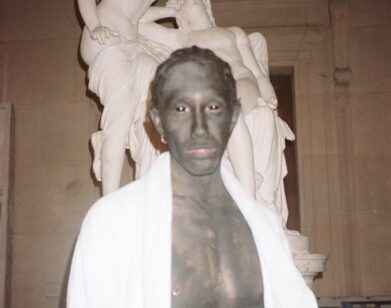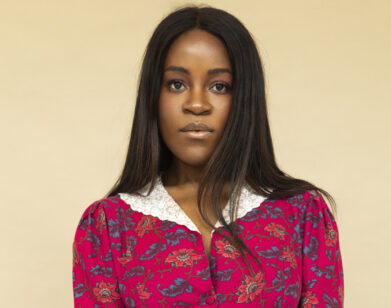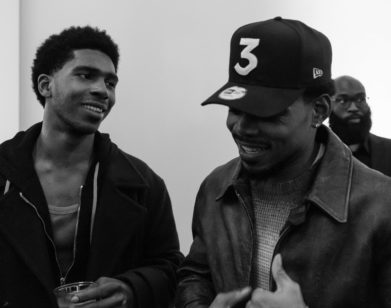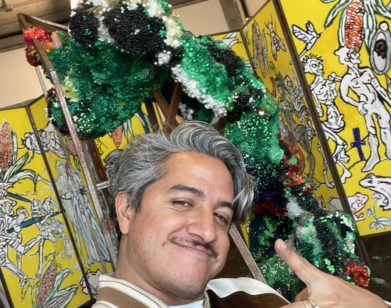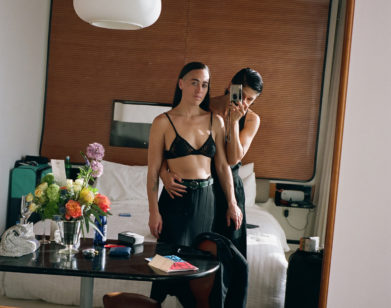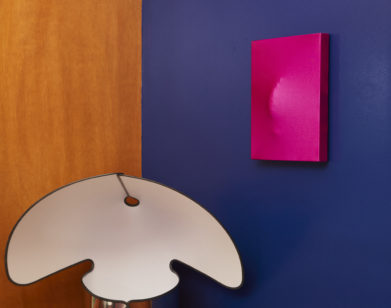VENICE BIENNALE
For Jonathan Lyndon Chase, A Masterpiece Emerges From the Rubble
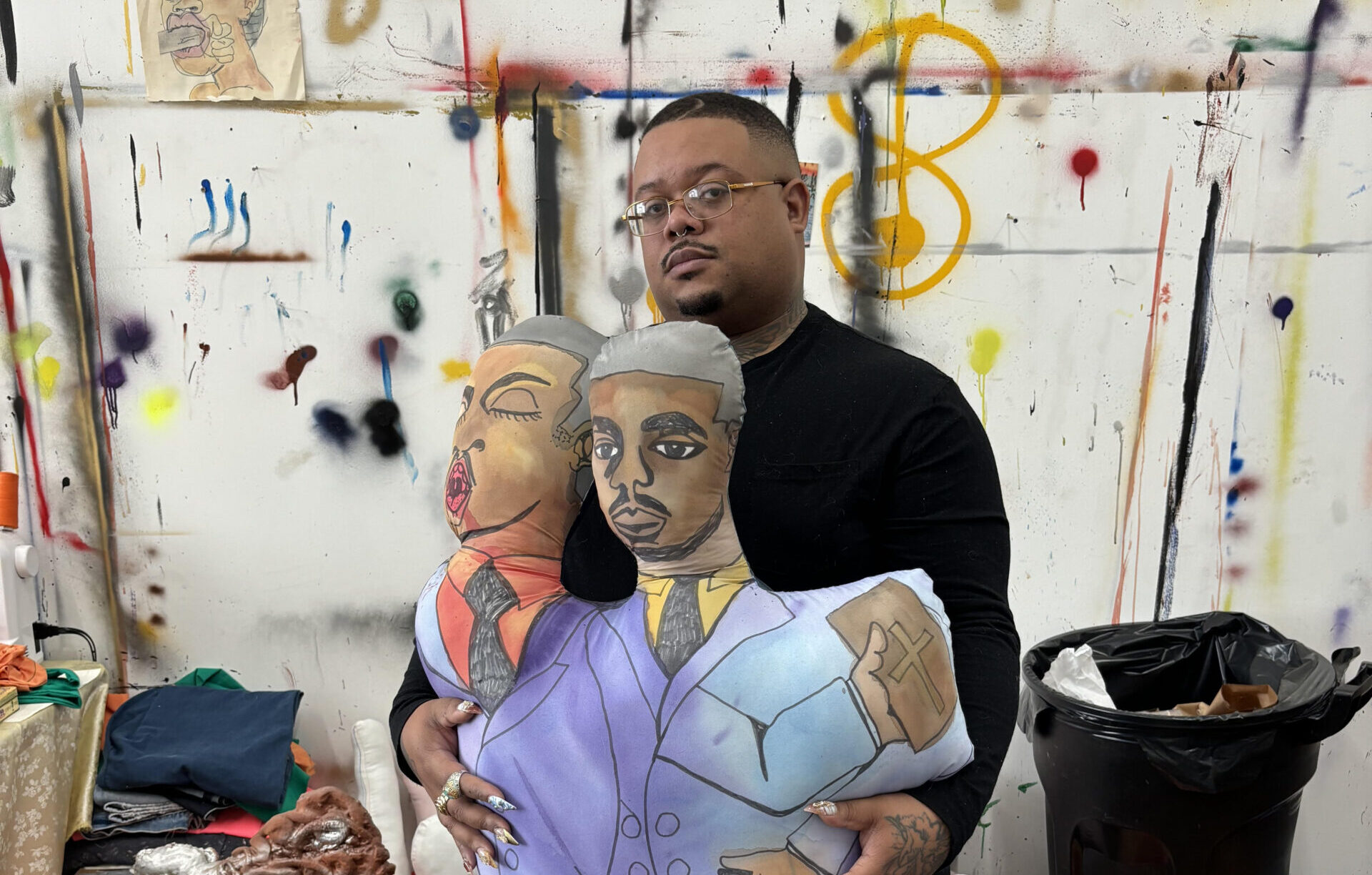
Jonathan Lyndon Chase, photographed by William Chase via Chase Studios.
Last month, In Praise of Black Errantry opened in the Palazzo Pisani S. Marina at the 60th Venice Biennale. Curated by Indie A. Choudhury and hosted by Unit Gallery, the exhibition surveys voices from the Black diaspora and it’s imaginaries. Included are works by the Philadelphia-based artist Jonathan Lyndon Chase, who decided to delve further into the worlds of Afro-futurism, mysticism and the human form. “I wanted to make something that talked about the body in a less physical way, more about what you don’t see on the surface,” they told their good friend and fellow artist Devin N. Morris on a call last week. In conversation, the two discussed fantasy, jazz, grief, found objects, and gawking at the barber shop.
———
DEVIN MORRIS: How are you?
LYNDON CHASE: I’m feeling good. Just taking it day by day. Are you in the studio?
MORRIS: Yeah.
LYNDON CHASE: Are you still doing Studio Harlem?
MORRIS: No, that ended in September last year.
LYNDON CHASE: Oh. Well congratulations again, I loved seeing your show.
MORRIS: Thank you. I loved your installation at Artists Space. It was so interesting because it’s a barbershop and in that space, queer masculine presence often doesn’t feel welcome. But I’ve always found it to be a space where I could like, yell at people [Laughs]. It’s a space for so much opinion, so I’ve always found it as a place to advocate for queerness, for women, and feel a little bit of push back on the noise.
LYNDON CHASE: Exactly.
MORRIS: There’s the camaraderie of it, and then also the sexuality of it and the desire and hidden parts like, “Okay, I can’t look too long, but he’s hot. I’m just in the chair. I’m not looking over.”
LYNDON CHASE: We’re just in the chair. We’re just here to do this. Get my haircut.
MORRIS: Right. Because you know how those straights be. They be so affected by just the suggestion of your presence. I’m like, “I’m not even taking you in…”
LYNDON CHASE: Right? Ain’t nobody even worried about you.
MORRIS: Like, you think that you’re the one?
LYNDON CHASE: The audacity of it. I woke up this morning and I was going to choose peace, so don’t let me be acting a fool here.
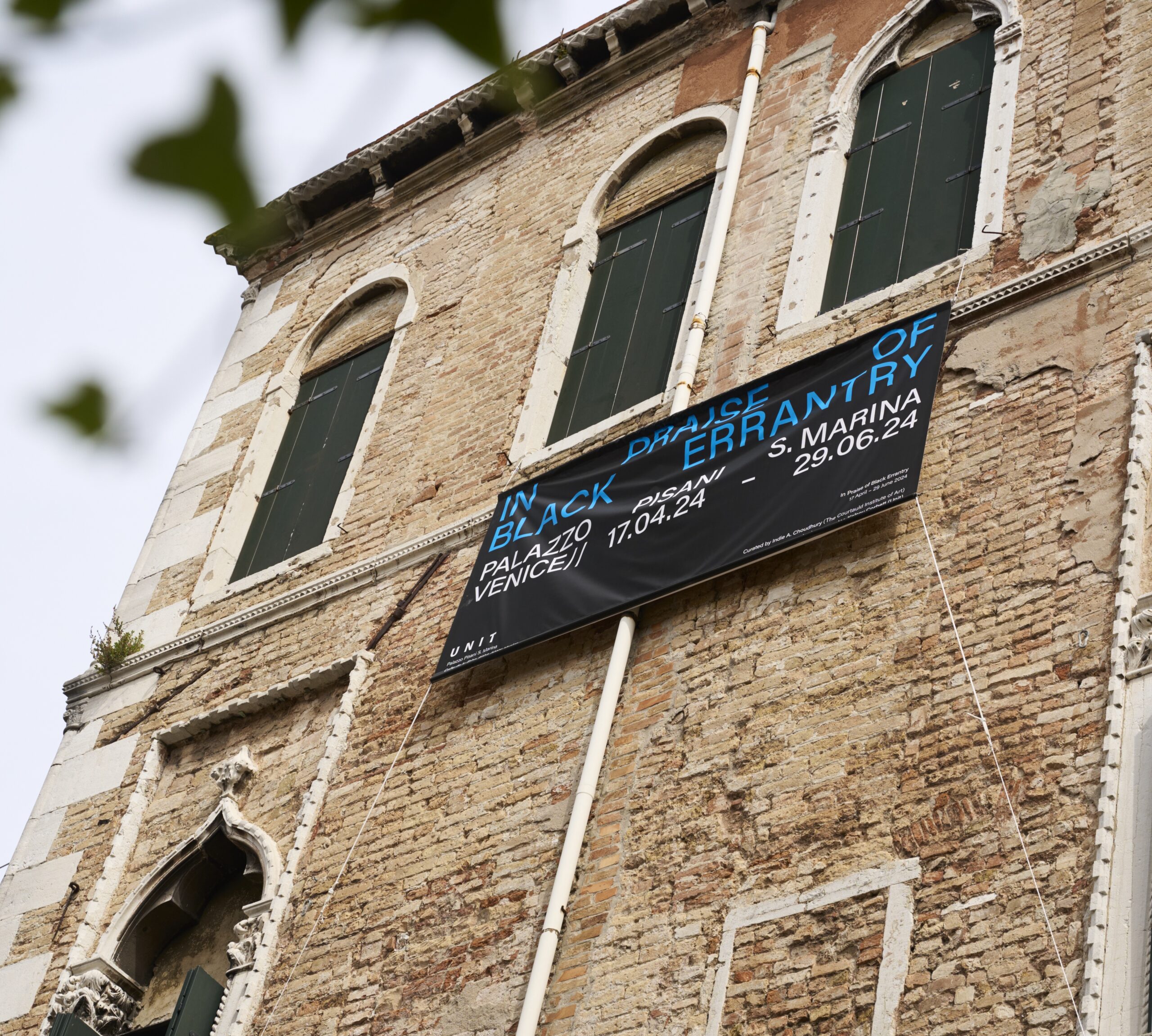
Palazzo Pisani S. Marina, Venice. Courtesy of Unit ©. Photographed by Studio Rio.
LYNDON CHASE: [Laughs] Right. Have you ever been to Venice or Italy or crossed over the–
MORRIS: No. I think about it though, because I’m always trying to physicalize history and space. Did you go for the opening of the show there?
LYNDON CHASE: No. I wasn’t able to go to Venice, but maybe someday. But I was happy to be invited to be a part of a really great show.
MORRIS: That show is amazing. And I love that term “errantry.” Even when I’m looking at your body now, the tattoos featuring your work, and seeing the space that you’re in, and I’m thinking about the freedom of the lines that go through your imagery, your sculpture, your space making and your being work. And how everything is always birthed out of a self. This term is phenomenal and it’s made for you.
LYNDON CHASE: I also wasn’t really familiar with it. It really resonated with me in a poetic way. This idea of imagination and wandering really made me think about Afro-futurism and fantasy. Imagination is a huge part of the show, too.
MORRIS: Yes.
LYNDON CHASE: A lot of people know a lot of my work from the mundane, everyday clothes that we wear, bedrooms and stuff like that. I was like, I’m going to go for things that lean more towards the mystical, spiritual or more fantastical. So I decided to make a painting and a sculpture.
MORRIS: Right. Where did Entropy come from as a title for the painting? And I’m wondering what the painting is placed on. It looks like there’s concrete on one side and then is that asphalt on the other?
LYNDON CHASE: Yeah. The painting is rested on a form of concrete that’s from going around Philly. A lot of my sculptures are made out of objects, but I really just find stuff dug up and broken from buildings or pavement. The painting Entropy is influenced by this older painting I did, Man with Heads. Some of the symbols are mismatched across, especially with the more fantasy elements. They’re about changeling metamorphosis throughout the spaces that we navigate, but also with the body. I wanted to make something that talked about the body in a less physical way, more about what you don’t see on the surface.
MORRIS: Right. I love that the body and the abilities of it are not expressed through the primary ways that we understand spiritual figures or even fairy tales. It’s like bodies on bodies on bodies on bodies, which for me almost feels like a mother carrying multiple babies.
LYNDON CHASE: Yeah. I’m very interested in this idea of what our bodies carry. If we take something like paper and crumple it, it always kind of holds a memory. And when I’m thinking of linear weight transparencies, they’re almost layers. I’m trying to play with deep space, but it’s flat at the same time.
MORRIS: Right. Dimensionality, and how it is its own forever. Is that a pathway from an interior to an exterior, that black portion behind it?
LYNDON CHASE: Yeah. I was describing most of my painting stuff as identifiable objects or spaces, but this one is more if it were an astral plane. I’m trying to relate it to the body as if the space is a type of body itself or multiple bodies that comprise something more complicated, very open and vast. I like to put sculptural elements with the paintings a lot, to almost balance it. The concrete and asphalt at the bottom is me imagining if a piece of those cliffs were entering our space.
MORRIS: I love that, and I love how you work through these soft sculptures. In my head, I’m going to call it a pillow, but how did you arrive at these three rounds?
LYNDON CHASE: The painting is on canvas, but I use muslin a lot because of the soakage capability it has.
MORRIS: It takes it so well.

Installation view of In Praise of Black Errantry, 2023. Courtesy of Unit ©. Photographed by Studio Rio.
LYNDON CHASE: Yeah. There’s always this waiting between mushing it around and then drying. A lot of my earlier paintings were very much soft and floral. I did a show on sheets once, and I got my sewing chops from my grandma and my mom. In this case I cut up the silhouette. It’s sewed and stuffed. You’ll see that there’s three faces or heads. For me, they’re both mask and face. It’s this question of whether you’re the same person or not. I wanted it to feel as sacred as I could get it. I spent a lot of time thinking about Marlon Riggs and Joseph Beam, and I started reading queer black theory and history and about the power of the mouth.
MORRIS: I’ve been thinking about that a lot. Sometimes when I see your characters, I think about sexual things happening. With these ones, I feel like that could be an idea, but it also feels like they’re singing. And then one is so quiet and settled.
LYNDON CHASE: Yeah. Along with work for the show, I’m working on a really cool catalog that I’m really excited about. I don’t consider myself a poet, but I do write poetry. So I made this kind of a talisman, a mystic tool for navigation. It’s like a compass with text in it.
MORRIS: Wow. That is incredible.
LYNDON CHASE: Thank you so much. It talks about the six senses and then astral plane, time, space, both private, public. I was really happy to get a bit outside what I usually do, but it’s still a part of what I’m more known for visually, in terms of subject matter.
MORRIS: I have the menu from when you did the dinner at Company [Gallery]. And I obviously have both of your books, and I’ve witnessed the way that your mind is always organizing, cataloging, remembering time, space, people, places, ephemera. There are so many writings, so much literature. I feel like it’s really a part of you.
LYNDON CHASE: Thank you. I feel like our work overlaps so much–
MORRIS: Definitely.
LYNDON CHASE: You like jazz a lot too, right?
MORRIS: Yeah. It’s probably the first way that I was able to understand collage. As I start making paintings nowadays, I realized that I don’t want to work from an empty canvas or surface. I like something that’s already affected, where the first decision is already made. Then I have to look at that decision and say, what’s the next line? I find that jazz does that. It has to. This person’s on a sax and now the drummer has to answer the sax. But the sax has to know when to let the drummer just go. I find that to be intuitive and I think it’s a really healthy language.
LYNDON CHASE: Absolutely. It’s also so free and liberating and raw. We were talking about concrete and asphalt earlier, and I wanted to say that I’m such a fan of how you search for items and bring out such beauty and sophistication in them. They do feel imbued with a spiritual quality, the way that they’re transformed.
MORRIS: Thank you. In the beginning of my practice, I wanted to pick up doors and moldings and iron and gates and things that I felt like were designed well and had a certain kind of collaboration of use already present in them. But it became more visceral for me last year when I lost my mom, and then I realized I couldn’t pick up large objects. I had to take walks because I needed to digest time in the day. I love walking, but I was literally so bereft that I couldn’t. It was like I was living, but not existing. All I could do was touch small things. That led me to a certain sensitivity and led me to process that death and the world I’m living in in Harlem. I always try to be careful of not being savior-y. I hate that idea. I’m not saving these objects, but I know that I’m doing a care act through this.
LYNDON CHASE: Yes. Thank you for sharing a bit of your story. There’s usually these people outside my studio who are always selling stuff like chairs, baby clothes, bric-a-brac and different things. I would always be like, “Hey, good morning.” They became part of my routine. One day they had a set of these doors, and it was right in the middle of me dealing with grieving my grandmother. I was also in a studio at that time trying to figure out this sculptural thing, and then this was there. And I was like, “Is this a cosmic sign?” So it was great that I was able to buy this set of doors from them. But more than often, it’s just me with no set plan. I’ll just take a walk or something or I’m driving and I’ll see something and pull over like, “Is this okay for me to take? I’m going to take it.”
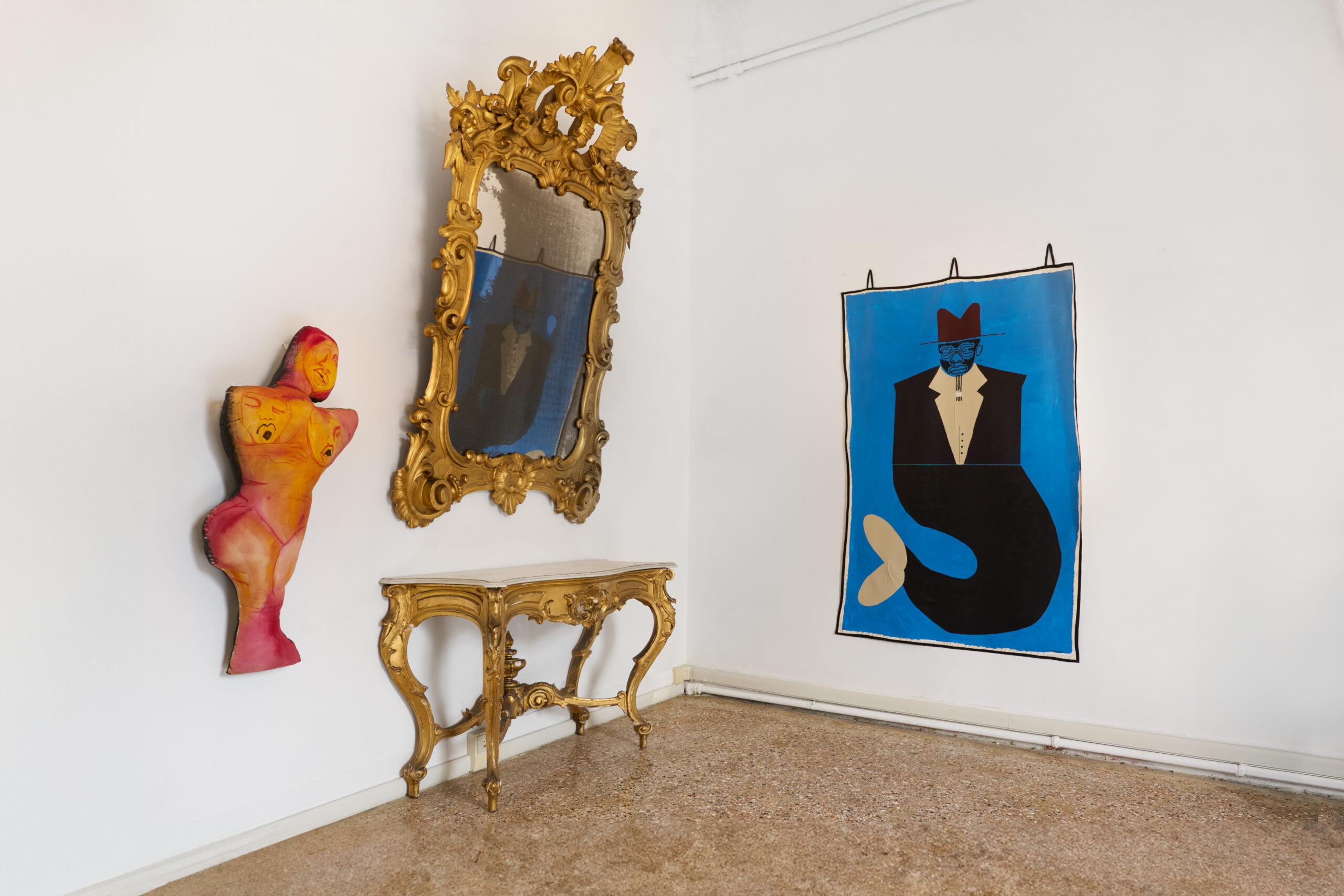
Installation view of In Praise of Black Errantry, 2023. Courtesy of Unit ©. Photographed by Studio Rio.
MORRIS: Right. You have to know you want to take something to take it.
LYNDON CHASE: I also like to take pictures of doors and houses. It’s always bricks and concrete with me. I remember once I was on a walk and noticed there was a person there and I was like, “Can I have your rocks?” They’re like, “I don’t fucking care.” I was like, “Thank you. You’re incredible!” So I just take them away. And they’re like, “Who was that?” I was like, “I’m an artist. It’s okay. I’m not weird.” Well, I am weird, but–
MORRIS: I think that’s a perfect ending.
LYNDON CHASE: Yeah. I miss you so much, Devin.
MORRIS: I miss you. Let me know when you’re here.

